Gestión de ventas: ¿Qué es? ¿Cómo conseguirlo?
Todo lo que necesita saber para dominar la gestión de ventas
¿Está preparado para convertir las ventas de un arte en una ciencia?
La gestión de ventas es la práctica de poner orden de forma eficaz en una profesión inherentemente desordenada y profundamente humana: las ventas.
But why should we care? Can’t we just keep our sales jobs super spontaneous and fun?
Nobody said that you can’t keep sales fun while bringing good sales management to your company, but it certainly is a requirement if you want to scale your sales and your business.
In this guide we’ll quickly cover the following questions for you:
- Primero lo básico: ¿Qué significa gestión de ventas? ¿En qué consiste?
- ¿Qué tiene que hacer un buen jefe de ventas?
- ¿Cómo puede mejorar su gestión de ventas?
- ¿Qué herramientas informáticas pueden ayudarte?
- ¿Qué libros y podcasts increíbles puedes consultar para seguir aprendiendo?
Si sólo desea leer sobre un tema concreto, puede hacer clic en la sección correspondiente.
Ready to get the full briefing in under 10 minutes? Without further ado, let’s dive in. 👇
Definición de gestión de ventas: ¿qué es?
Sales management is the practice of creating a successful sales team by continuously building that team, setting out strategies for it, tracking its results, adjusting its processes and coaching its members to consistently hit your business’ sales targets.
Dividiéndolo, esto significa que la gestión de ventas abarca generalmente tres áreas:
- Gestión de personalConstruir, entrenar y retener al equipo de ventas.
- LiderazgoDesarrollar procesos y estrategias de venta eficaces
- Ventas análisis de datosSeguimiento, informes y ajustes
If you effectively take control in these three areas, it will make sales more predictable for your business. No more accidental wins. You’ll have a solid and successful business.
Sounds good? Let’s explore what this means day to day and what concrete steps you can take.

Funciones y responsabilidades de un jefe de ventas
¿Qué debe hacer un jefe de ventas en su día a día para garantizar el éxito de su equipo comercial?
Well, here’s the different sales management responsibilities you need to pick up.
1. Contratación, compensación, retención y evaluación de un equipo de ventas
Las ventas son interacción humana. Y no se consigue la grandeza de las ventas sin un sólido equipo de ventas.
Esto significa que necesitas:
- Incorporar grandes jugadores al equipo de ventas
- Motivarles para que rindan con la compensación de ventas adecuada.
- Mantenerlos en el equipo
- Evaluar su rendimiento y tomar medidas
2. Planificación y dirección
Ni siquiera un gran equipo puede rendir si no se le da una estrategia, un plan o una dirección.
Tu trabajo consiste en decidir en qué áreas centrarte, cómo hacerlo, cuándo, etc.
Esto incluye:
- Fijar objetivos (más adelante)
- Definir tácticas de generación de leads (más adelante también).
- Assigning reps to different geographic areas, sectors, accounts, …
- Perfeccionar el proceso de venta
- Cualquier otra ayuda que necesiten sus representantes
Toma las riendas, orienta y asegúrate de que todos miran en la misma dirección.
3. Coaching de vendedores
There’s higher level guidance, and then there’s coaching sales reps to improve their daily practice.
Depending on whether you do inside sales or field sales, this will mean you’ll have to listen into sales conversations on the phone (either live or recorded) or join them on the road to take part in meetings. Based on this you can help them with how to approach sales conversations and be more effective. This practice is called “shadowing”.
También puede consistir en enseñarles a escribir correos electrónicos más eficaces, a redactar mejores propuestas, a negociar mejores acuerdos, etc.
4. Alineación y colaboración con otros departamentos
Your sales team is probably not alone in the company. And as you serve the customers, you need to interface with most of the other departments to do this better: marketing, finance, product, …
Your job is to represent your team as well as possible. For example, when your call centers receive inquiries and promise that a sales rep will follow through, it’s your responsibility to be ready to be of service. Alignment and proper workflow is important. Your job is to make sure that you work well together with the other teams and that information is exchanged as easily as possible, but also to give your team the necessary space and protection to do their job as well as possible.
5. 5. Informes y análisis
Last but not least: you need to be on top of the numbers. Know exactly where you are versus targets, how well your team is performing, and where you can adjust or refocus to increase sales. Sales reporting is essential to optimizing your sales strategy or if it’s time to try something different.
This of course means you’ll need to have all the data to support this, which is exactly the first thing to implement when building a strong sales management system:
Sistema de gestión de ventas: procesos y estrategias para conseguir esas cifras
Now that we know what sales management means and what your responsibilities as a sales manager are, let’s look at some processes and strategies you can implement to be successful at it.
1. Reúna todos los datos necesarios para organizarse y probar estrategias
If you don’t know what’s happening, it’s very hard to properly take up most of your tasks. That’s why gathering data is one of the key steps you should take and there are plenty of tools, for example, scraper API that can help you with that.
Lo ideal sería disponer de datos sobre:
- Con qué empresas están en contacto sus representantes de ventas, cuál es el estado de cada una y cómo avanza cada conversación.
- Cuántas oportunidades tienes en el pipeline de ventas, en qué fase, de qué valor, por cuánto tiempo, etc.
- Cuán activo es su equipo de ventas y a través de qué canales
- How many deals you’re winning and how many new opportunities you’re adding to your pipeline
- De dónde proceden los clientes potenciales y por qué se suelen perder oportunidades
- Qué empresas le aportan más ingresos
- Qué oportunidades se escapan
Un buen CRM de ventas puede ofrecerte esa información en sus dashboards.
If you’re using Salesflare, you have a Revenue dashboard:
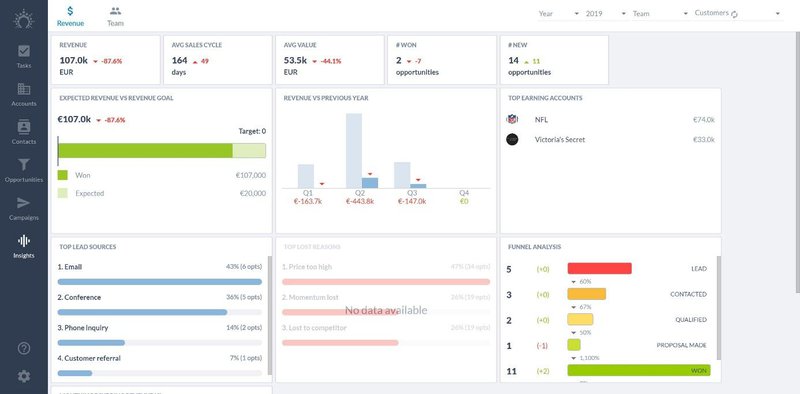
And there’s a Team dashboard:
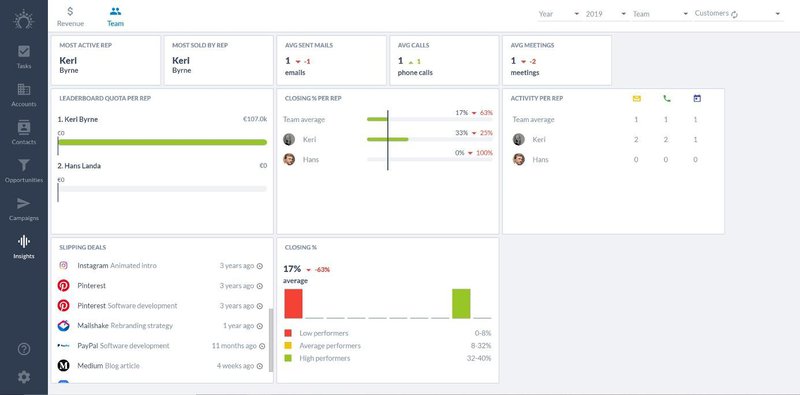
Por supuesto, primero hay que recopilar los datos, y la mayoría de los CRM exigen que los representantes de ventas los introduzcan manualmente. Esto requiere mucho tiempo, energía y disciplina.
That’s actually why we created Salesflare: to automate that data input and easily provide you with all the data you need, without stressing out your sales team. But more on that on our website.
2. Proporcione información continua a su equipo de ventas
Data is no good if you keep staring at it and don’t put it to use.
Utilízalo para saber exactamente cómo lo está haciendo tu equipo. Averigua cómo pueden mejorar. Y luego, por supuesto, háblales de ello.
Cree circuitos de retroalimentación sólidos para mantener a sus representantes de ventas alerta y en constante mejora. Asegúrate de que saben cómo lo están haciendo y cuáles son los puntos principales en los que pueden trabajar para tener más éxito.
Don’t forget to put positive feedback loops in place as well. You can for instance hook up your CRM to Slack to communicate and celebrate wins. This can both bring a great atmosphere to your team and spur their competitive drive.
3. Garantizar una buena afluencia de clientes potenciales al canal de ventas
Without a good inflow of leads, your sales team’s performance can quickly drop to near zero.
If your sales reps are both responsible for creating new leads and for closing them, you’ll find that the team will naturally start working in cycles: first they have a lot of leads in the pipeline and they’re only working on closing them, then they run out of leads and start filling the pipeline again, after which the cycle restarts. This creates a lot of instability in the way your sales team functions.
To build a sales team that runs like a clock, it’s best to take responsibility over this area as the sales manager.
Either you work together with the marketing team to provide these leads, or – as one of the books in our below selection, Predictable Revenue, prescribes – you can divide the tasks of creating and closing leads in two different roles.
4. Contratar y retener a un equipo estelar
This one might seem obvious and we’ve touched upon it above, but we need to stress it again: building the best sales team is key.
It’s also more difficult than it might seem, because:
- Great sales people aren’t easy to find; and if you find them, they’re pretty good at selling themselves to other employers too.
- They’re also generally not that easy to retain, so you’ll need to go out of your way for this.
- If you make the wrong hiring decisions, you can’t keep up with bad hires forever. And firing people is notoriously hard to do.
- Even if you have the right people on board, they might lack motivation, direction, … or anything else that prevents them from being successful.
Por lo tanto, le recomendamos que dedique al menos un tercio de su tiempo a trabajar en la creación de su equipo y sus capacidades.
5. Establecimiento de objetivos, previsión y seguimiento
Mucho más fácil de implementar y clave para cualquier gran organización de ventas: objetivos por los que trabajar.
La métrica de objetivos más esencial es un objetivo de ventas anual por representante de ventas. De este modo, cada comercial sabe exactamente en qué tiene que trabajar y cuándo se considera que ha tenido éxito.
Tanto si está de acuerdo con la filosofía de establecer objetivos más bajos y alcanzables para aumentar la confianza de sus representantes de ventas (que aumentará gradualmente), como si está de acuerdo con la filosofía de establecer grandes objetivos audaces para llevarlos a nuevas cotas, hay que poner el listón alto.
After you’ve defined the targets, set them in your CRM and track them in dashboards that are internally visible to everyone in the sales team, so they can all clearly see where they’re at.
Debe visualizarse a nivel individual:
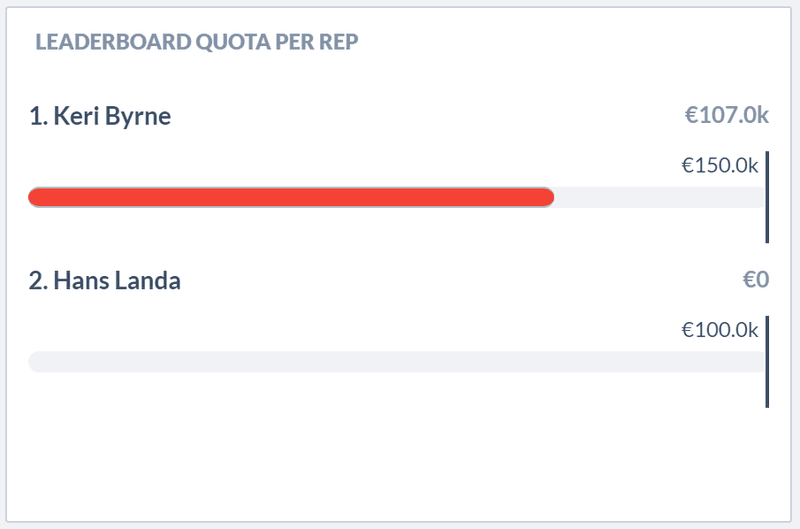
Y también a nivel de equipo (con todos los objetivos sumados hacia un objetivo de equipo):
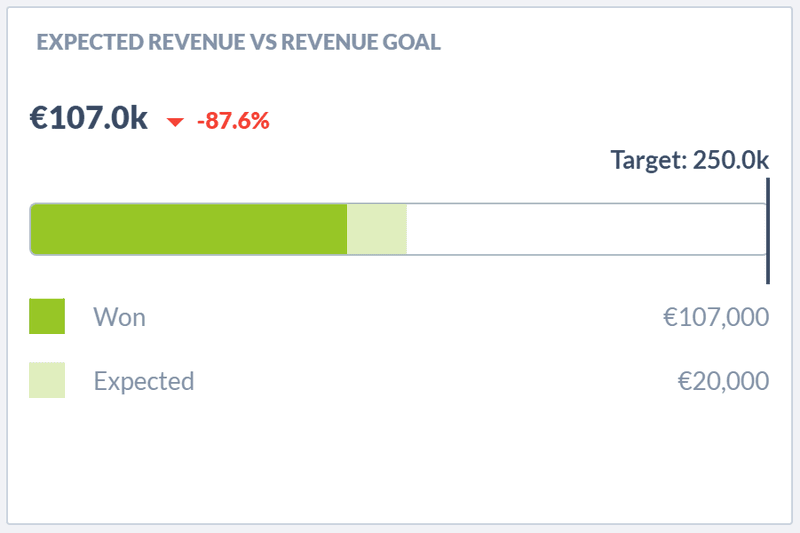
Para conocer el progreso hacia estos objetivos, un buen director de ventas suele planificar reuniones semanales o quincenales con cada uno de sus representantes de ventas para repasar su cartera de oportunidades. En ese momento, puedes decidir junto con el representante en qué operaciones centrarte y qué pasos dar a continuación.
Dicho pipeline de ventas se visualizaría típicamente como un tablero Kanban de arrastrar y soltar en su CRM.
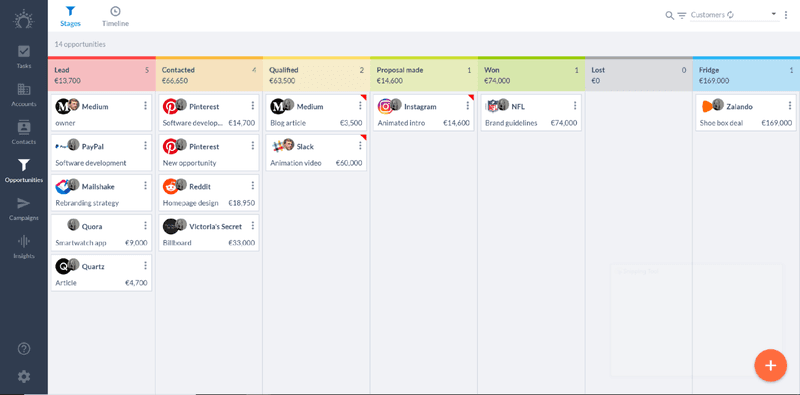
Herramientas informáticas para la gestión de ventas: CRM y más allá
Mientras que los datos son críticos para muchas responsabilidades de un vendedor, en estos días, afortunadamente, una gran cantidad de nuevos software de gestión de ventas herramientas aparecen para ayudar a los gerentes de ventas con seguimiento de que los datos de ventas mejor y más fácilmente.
Central to all this is the CRM, but it’s definitely not all there is to help you.
1. Elija un CRM de ventas
Aunque existen muchas categorías de CRM, un CRM de ventas específico le hará la vida más fácil.
Un buen CRM de ventas proporciona a los comerciales una herramienta práctica para organizar sus ventas (mientras que un CRM empresarial se centra más en proporcionar valor a la dirección), lo que significa que serán más propensos a utilizarlo y que usted dispondrá de los datos que necesita.
A la hora de elegir el más adecuado, le sugerimos que se base en estos criterios:
- Experiencia del usuario: Again, if your sales reps don’t use the CRM, you can as well not have one.
- Accesibilidad móvil: If you want them to really use the CRM, you can’t keep them chained to a computer.
- Capacidades de automatización: La automatización puede aumentar la productividad de las ventas, pero también aportar más datos con menos trabajo.
- Precios: ¿Cuánto pagas por todo este valor?
- Ayuda: Can you expect help when you’re in trouble?
To save you some time, we’ve compared the most popular CRM options for you here.
Spoiler: estos son los criterios que realmente creemos que son más importantes, por lo que objetivamente encontrará que, cuando se trata de estos criterios, Salesflare supera a los demás. Este es especialmente el caso cuando se trata de automatizar la entrada de datos para sus representantes de ventas, lo que a la larga le asegurará que tiene todos los datos que necesita.
2. Entrenar a los representantes con un software de seguimiento de llamadas
To make the job of “shadowing” your sales people’s phone conversations more easily at scale, in recent years software companies have been founded like Refract.ai and Gong.io.
El software grabará y analizará las conversaciones de ventas y le proporcionará información útil, como qué hacen sus mejores vendedores en las conversaciones para tener éxito. También te dará recomendaciones sobre cómo cada representante puede mejorar sus conversaciones.
Si bien es cierto que estas plataformas tienen un precio elevado, resulta interesante considerarlas en cuanto se amplía el equipo a unos 5 vendedores internos o más.
3. Difusión y seguimiento del uso del material de venta
If you have a big sales team and you don’t know:
- Si sus comerciales llevan y utilizan el material más reciente
- Cómo utilizan este material con los clientes
Entonces puede que quiera echar un vistazo a software de habilitación de ventas como Showpad o Clearslide.
No sólo le ayudará a resolver estos problemas, sino que, por ejemplo, también ayudará a sus representantes a encontrar el material adecuado para el cliente adecuado en el momento adecuado.
Again, this is also mostly meant for bigger companies. If you’re small and lean, you probably won’t need this and won’t want to put down the money.
4. Compleméntalo con muchas otras herramientas de venta
Existen muchas otras herramientas que pueden aumentar la productividad de las ventas.
That’s why we compiled a list of the top sales tools you can look at.
If you’re using Salesflare already or would be looking to use it as your CRM, check out some of our integrations with other tools here. You can connect Salesflare with 1500+ other tools using Zapier, Integromat or PieSync.
Libros de gestión de ventas: los 5 mejores recursos (y un bonus)
We’re not leaving you without some of our personal recommendations for further learning material. Below are 5 of the best sales management books you can read, plus some amazing podcasts.
If you’re into sales books in general, check out our selection of the best sales books as well.
Gestión de ventas. Simplificado: La pura verdad sobre cómo obtener resultados excepcionales de su equipo de ventas, por Mike Weinberg
Mike Weinberg believes that managing sales teams doesn’t have to be complicated. In this book he highlights what to do and what not to do to be a great sales manager. It’s an honest read full of practical tips and can be easily read in a few takes.
Sales Manager Survival Guide: Lessons From Sales’ Front Lines, by David Brock
If you’re looking for a slightly meatier book, endorsed by the author of the previous book, this book by David Brock might be what you’re looking for. It’s a full guide to front line sales management, that covers many of the points we’ve touched above in a lot more detail. If you’re looking for a sales manager handbook, grab this one.
Ingresos previsibles, por Aaron Ross y Marylou Tyler
Aaron Ross, previously a guest on our Founder Coffee podcast, explains how to build a modern sales organization, just like the one he helped building out at Salesforce. His main premise: separate your sales team into different roles. But that’s not all he discusses in the book. If you’re looking to improve your team’s sales processes, we recommend you read Predictable Revenue.
Coaching Salespeople Into Champions: A Tactical Playbook for Managers and Executives, de Keith Rosen
Want to improve your sales coaching skills? Keith Rosen’s book covers exactly that topic, with a lot of detail. It might not be the most exciting book to read, but it’s an absolute must read for sales managers (and maybe even managers in general).
Descifrando el código de la gestión de ventas: The Secrets to Measuring and Managing Sales Performance, de Jason Jordan y Michelle Vazzana.
Por último, este libro trata sobre métricas de ventas. Es un libro muy detallado, que puede resultar un poco repetitivo hacia el final. No obstante, tómelo, lea la primera parte y empiece a medir y gestionar su rendimiento de ventas como nunca antes.
Bonus: Prefer listening? Here’s some great podcasts.
Spending some time on the go? You probably are. So why don’t you listen to some podcasts and keep your brain moving.
We’ve listed all the best sales podcasts for you.

Esperamos que te haya gustado este post. Si es así, ¡difúndelo!
👉 Puede seguir a @salesflare en Twitter, Facebook y LinkedIn.
if(window.strchfSettings === undefined) window.strchfSettings = {}; window.strchfSettings.stats = {url: “https://salesflare.storychief.io/sales-management?id=1563153716&type=2”,title: “Sales Management: What is it? How to nail it?”,id: “b4bf56dd-9b24-4318-a472-b8522fe85e05”}; (function(d, s, id) { var js, sjs = d.getElementsByTagName(s)[0]; if (d.getElementById(id)) {window.strchf.update(); return;} js = d.createElement(s); js.id = id; js.src = “https://d37oebn0w9ir6a.cloudfront.net/scripts/v0/strchf.js”; js.async = true; sjs.parentNode.insertBefore(js, sjs); }(document, ‘script’, ‘storychief-jssdk’))- 8 beneficios del CRM + 6 retos a superar primero - 18 de abril de 2024
- 30+ Mejores herramientas de generación de leads (por tipo) - 16 de abril de 2024
- 7 Mejores CRMs para Google Workspace + Funciones de Integración - abril 11, 2024
